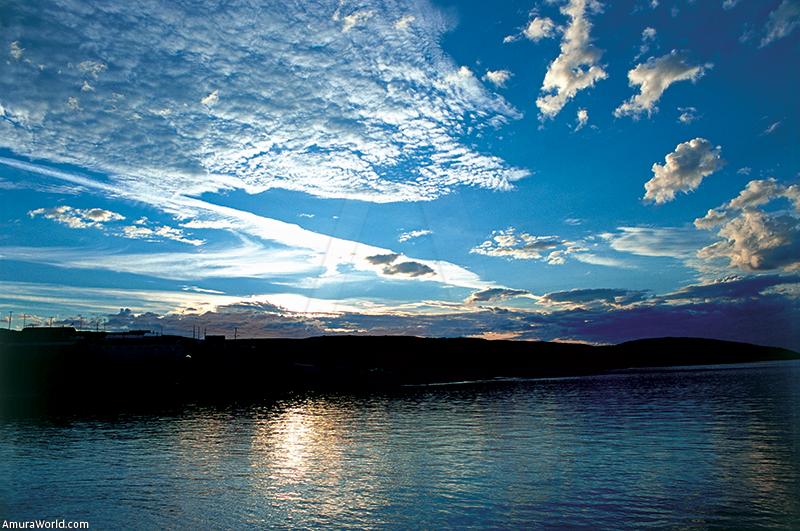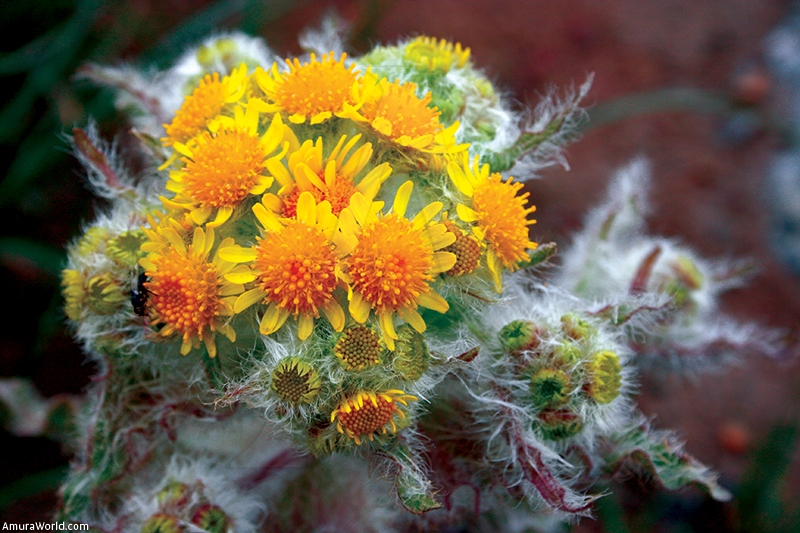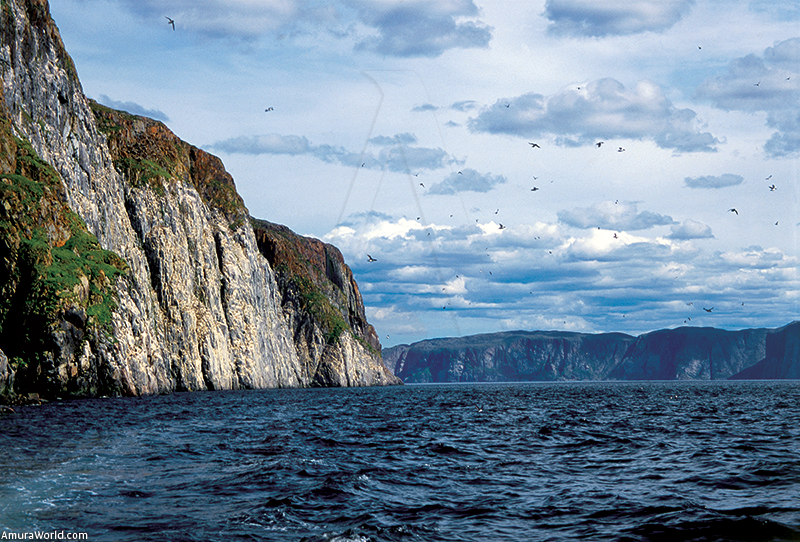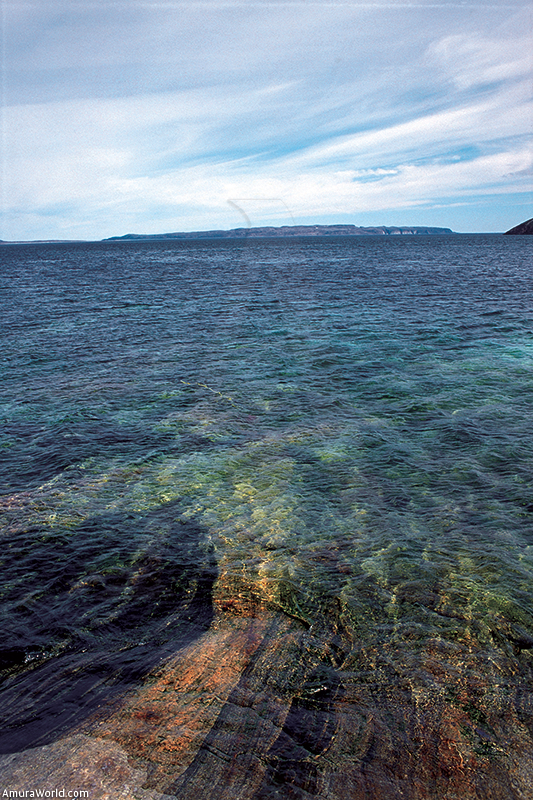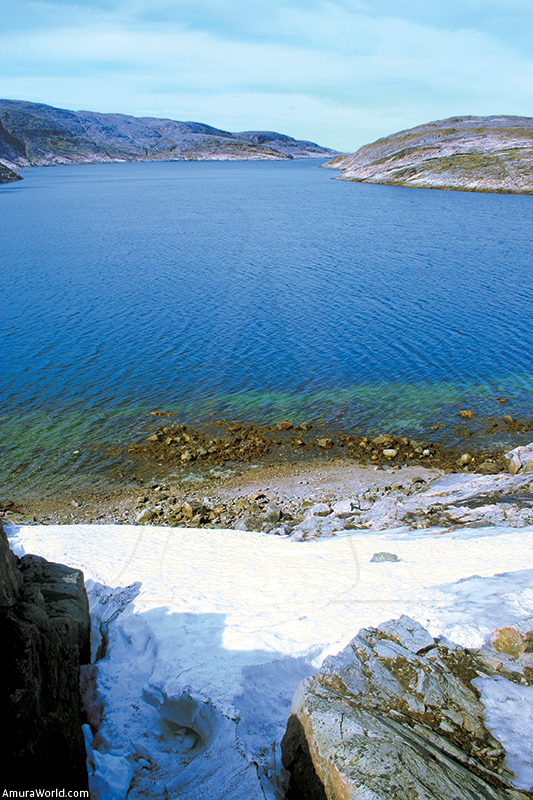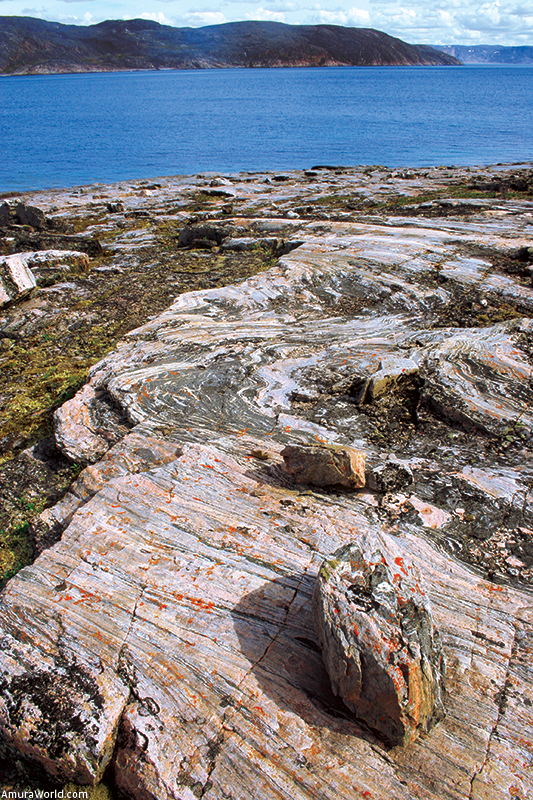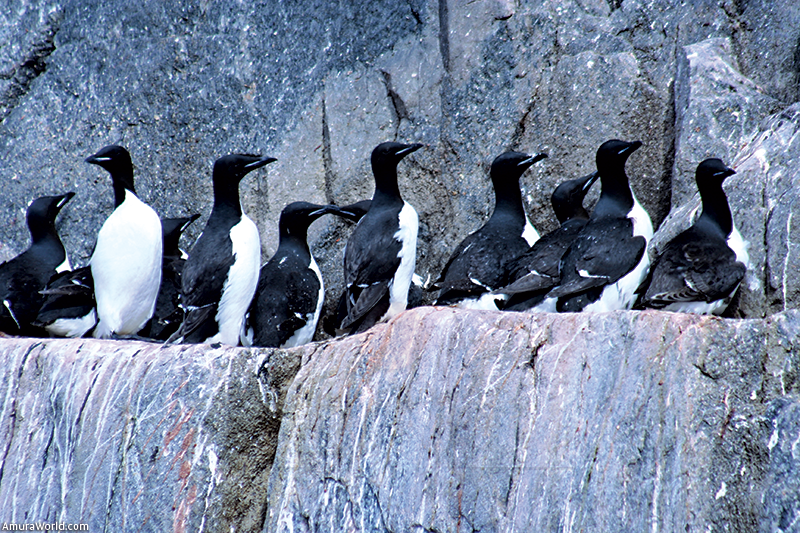With the Inuits the Hudson Bay
North of Quebec province exists an unknown world inhabited by the Inuit of Canada. In this world, shadows lengthen, the sun disappears at midnight only to rise two hours later, and the endless winter covers everything – including the sea – with a white layer of snow and ice. The glaciers have left their prints over the rocks, sculpting a unique landscape with few mountains and many lakes. The coast is impressive and life itself is intriguing. This mysterious world north of Parallel 55 lies just beneath the Polar Circle.
The boundary of this great peninsular is found to the west of Hudson Bay, a land-locked ocean to the south of the great natural canal that connects the Atlantic with the Pacific, utilized by ships when the ice melts. On the northern border lies the Hudson Straits, a route frequented by whales, and Ungava Bay, where the unusual landscape seems to defy the extreme climate. To the east, waters from Shepherd Bay bathe the coast, which looks out toward the Atlantic. The only limit in this region is the horizon, upon which the sun sets as if trying to hide, and reappears as though frightened to remain at a distance.
The sunsets seem eternal and the stars play on the horizon, continuing to twinkle, until at last they touch it at 12 midnight. Afterward, the light refuses to disappear, remaining lit in a continuous glow. This is when the birds sleep and people rest. At three in the morning, the light becomes more intense and the sun illuminates the coast where the hills lower toward the sea.
The coast is dotted with small islands bathed in crystalline waters and great rivers that plunge toward the sea after having traveled across the tundra. Here there are no trees and the lakes are the fruit of waters that remain trapped, revealing moss covered rocks and an array of flowers that blossom profusely during the short summer, these summers of endless sunsets.
In this region there are no highways and Air Inuit planes connect all 14 of the main towns. The sea is the best form of communication, allowing the Inuit to travel in canoe during the summer and dogsled in winter, when the sea turns solid and white. The Inuit’s’ traditional way of life forced them to live in igloos once the nights became longer, and in seal skin tents when the moderate heat began to melt away the ice.
The Inuit are descendants of the Thule people, a branch from Asia that populated this region after crossing the Bering Strait when it was frozen during the glacial era. The Thule appeared in the region during the 13th century, eventually replacing the diverse Palo Eskimo ethnicities that inhabited the Arctic at that time. In the 18th and 19th centuries, they established contact with the white civilization in order to exchange animal skins, at which point their traditional way of life began to change.
Before this occurred, Inuit women played a very active role, scraping fat from the animal skins which the men brought back from hunting, chewing the skins with their teeth to make them soft and then stitching with bone needles, transforming the skins into clothing for the entire family, including boots. The men hunted seals, whales, bears, wolves, fox and caribou for food and clothing; with the bones they manufactured instruments, moved about on dog sleds and traveled for days to chase bear and caribou. The animal fat was used to heat the inside of the igloos and help its inhabitants withstand the extreme climate. They were strong, brave, defiant and proud people.
Today, life has changed. The government sent them pre-fabricated houses with heating and integral kitchens. The scarce pueblos relocated along the shore, with hospitals in the largest, church, cars, ATV’s (all terrain vehicles) snowmobiles and small ports. Now the Inuit hunt only for recreation, fish only for sport, and go camping in cloth tents. They spend much time, however, in the supermarket. Life is no longer what it once was.
“Ai, qa-un-i-kiit”, Hi, how are you? This is the Inuktituk greeting, a language that the Inuit continue to use, thereby continuing to maintain an old linguistic tradition in spite of the modern world, a much different world. Their written language is also commonly used, although television now occupies a significant part of their lives.
The Inuit are charming and very sociable; some craft intriguing stone figures that represent bears and seals, as well as hunting and fishing scenes. Caribou and reindeer horns taken from animals that inhabit the tundra are also used to create magnificent works. Raw fish continues to be a staple of the Inuit diet, cut into slices that are turned with the skin inside and then delicately sliced into pieces. Caribou, goose, duck seal and whale are also prized dishes, acquired as a result of organized hunts.
Caribou herds inhabit the tundra and taiga of Nunavik; in fact, the largest herd ever observed – nearly a million animals – has been seen in this region. The animals’ annual autumn migration is a unique world event; their territory extends along the entire region north of Quebec province. Caribou eat the lichen that is found here in abundance, and migrate to find it. The Nunavik Inuit once depended heavily on these animals for food, and produced qulittaq with their skins, an overcoat renowned for its thermal properties and stitched together with dried caribou tendons.
Although the Inuit are coastal people, some followed the caribou herd inland during the winter months, when the frozen snow and ice facilitated their movement. Here they constructed inukshuit, piles of stone recognizable from the far reaches of the tundra. These hills were built to scare the caribou and direct them toward places where they could be ambushed. The Inuit considered them to be watch posts, signaling where humans once lived and, most importantly, that the place was inhabitable. Winter is a time when travelers can move safely on firm ground, both on island and land, thereby avoiding water and lakes and assuring that the risk of breaking ice was lessened. Nowadays, caribou hunting is considered a sport highly esteemed by both the Inuit and Quebecois.
Umiujaq
On the coast of the great circle-shaped gulf, we arrive at Umiujaq, a small village that features a long sand beach that entices one to take a leisurely stroll. Children bathe in the river, people walk to the supermarket, others play baseball; the streets smell of earth, the wind blows through the wood houses, all of which appear to be identical. It seems like a place far removed from Earth, with the sun’s bright rays sparkling in the water and the sky mixing with the sea. In the small port, we prepare the motorboat to explore the region.
The rocks are beautiful, with red and yellow crystal inlays; green and brown stones sink in the transparent water. On the alluring beaches are footprints of bear, fox, caribou and ducks. The small waterfalls plunge toward the sea, and the scenery is beautiful and wild. Umiujaq is above the vegetation line, the borderline of trees that make up the northern forest where only short pines grow. North of this line, there are no trees, only lichens and moss, as well as some types of plants and bushes.
Upon navigation in our canoe we are able to admire the region’s beauty, where the sky frames the hills. We follow the route toward the south, on the cusp of mountains that lower seamlessly toward the sea, a shore protected by several flat islands.
We arrive at the narrow pass known as “Goulet”, an authentic canyon that connects the Hudson Bay with Richmond Gulf, an immense bay enclosed by land. In the Goulet pass, the current is so strong that it never freezes; it is the favorite spot of beluga whales, salmon and trout. We take advantage of the rising tide’s strong current to travel cross.
The Richmond Gulf is surrounded by strangely shaped hills, forming a spectacular scene of waterfalls and rivers that fall forcefully, making ideal places for camping. Finally, when the sun goes down and the wind begins to freeze our skin, we reach the long beach at the end of the gulf, the furthest point from the sea. At this time, however, the tide has already reached the sand, and a well-regimented army of mosquitoes begins to attack in their favorite location.
A car awaited us for our return to Umiujaq, only a half hour away, whisking us across the last northern forest of midget pines. In the tenuous darkness at one in the morning, we ran into a wolf searching for his midnight supper.
The Umiujaq region is remarkable, with impressive geographic characteristics and, even more impressive, lakes, rivers and hills that conceal a host of natural treasures. The shore is comprised of endless, charming little crooks and crannies with beaches that snuggle against the foothills.
Puvirnituq
The plane takes us north, to Puvirnituq, a town more important than Nunavik and located at the river’s edge, in an area full of lakes and rivers in the midst of tundra where trees no longer grow. The town is bustling, with a hospital that receives patients from far off places, a charming hotel, and two supermarkets that drew the Inuit into the streets on any pretext. Children play at the water’s edge, bathing in the sunset; sled dogs wander on the islands during the summer, their barks audible; all traction vehicles scurry through the streets; and friends meet up and greet each other.
We leave in motorboat and follow the shore, extremely flat toward the north, passing between islands and confronting the cold and waves. Finally, after two hours of navigation, we arrive at an island in which a summer camp had been set up. We were received enthusiastically and invited to a meal that was about to begin.
In one of the tents was the dining room, with everyone seated on the ground in three double lines. At the middle table raw fished was served, sliced in circular pieces, which the specialist turned over to leave the skin inside and then cut into slices with a small, sharp sickle. They seemed like red bracelets, and each person grabbed one and ripped off an already prepared chunk, leaving blood to stain the floor. In the other lines, cooked caribou and goose meat were served, both strongly flavored. Outside very thin pieces of caribou were hung up to dry. This meal was an absolutely fascinating, ethnographic experience.
After eating, we left in canoe to follow along the shore, delineated by islands, small coves, rocks and beaches. The trained eye of Paul Kusugak, our companion, discovered a group of six caribou from afar. We walked toward them slowly, timidly and in silence. It was incredible to observe these animals, with their immense horns, elegant bearing and silhouettes standing out against the gray sky.
In the midst of superb scenery, one feels the great solitariness of the north and the summer cold that chills to the bone, while the sea licks the rocks that would soon be covered in ice and snow. It was a fabulous sensation.
We returned to Puvirnituq when the sun set below the horizon, painting the sky with fabulous colors. From there we left along the only way out, a four-kilometer path that eventually took us to a lake. Stunning scenery with caribou, salmon swimming in rivers, and lichen and summer flowers.
Ivujivik
The route from Puvirnituq to Ivujivik in airplane allowed us to admire the magnificent scenery from above, the shore delineated by ice left by thousands of strangely shaped islands, bays, estuaries and peninsulas, like that of Akulivik. Finally, the plane descended and landed in a small, deserted airport. This town spread out over a long peninsula in the middle of the sea, reflecting the brilliant summer light.
We finally arrived in Ivujivik, the town furthest north of Quebec, surrounded by impressive cliffs that plummeted into the waters of the Dignes Straits. The two streets led to the beach, exposing identical houses and children playing baseball. The main place to meet seemed to be the supermarket. Here nighttime was shorter, the cold more intense and the scenery even more spectacular. From the eastern point, the inhabitants built an observation deck to watch whales and hunt them with rifles. This is the best spot to enjoy the setting of the eternal sun, when the bright star falls in a nearly horizontal trajectory and lights up the entire horizon.
The following day we left in canoe with Adamie Kalingo to follow the fiords where violent torrents of water and fabulous bays emptied out, and where waterfalls plunged from the highest cliffs. Although we observed caribou, we didn’t have the fortune of encountering nanuq (polar bear).
On these cliffs nest the “thick billed murre”, birds similar in appearance to penguins, with short wings that still allow them to fly. They launch themselves from the high rocks in order to take flight. Immense colonies, especially on Digges Islands, mark the straits where violent currents cross and assail Cape Wolstenholme.
These birds painted the cliffs with their white excrement, making the rocks vibrate with movement. They wander until finally stopping in front of the rocks and turning to the side to catch a glimpse of the water. They seem like clouds that fly together with seagulls, offering an impressive show.
Our motorboat tour was unforgettable, allowing us to discover majestic scenery and deep bays, as well as seals and puffin, birds with a colored beak that make them look like clowns. We traveled across beautiful fiords adorned with waterfalls so clean that we could drink the water, until finally reaching Cape Wolstenholme and returning along the coastline of the islands. In one of these, we settled into a deep bay ornamented by ice and, after walking along a landscape punctuated by black rocks, ran into the remnants of an ancient town of rock.
We appreciated the great diversity of flowers that flourish in the short summer months, admired the sumptuous scenery and eventually found the remains of a whale.
We navigated toward the southeast, traveling across canals hidden between islands and peninsulas. We also observed eagles as they hunted, caribous as they grazed and fishermen set up in camps. The seaweed moved with the dance of the waves, following the rhythm of the tide, and the seals played. The immensity of the physical space in which there were no houses created the sensation of being alone in a still virgin world. The experience of navigating in tranquil waters amidst coves hidden between islands and cliffs, inhaling pure, cold air, was sensational.
Nunavik is a land without limits, seductive, intriguing, the last remaining adventure paradise. In this remote and extreme region, communion with nature is made more intense in the tenuous light that casts long shadows over the polar lichen and flowers. Adventurers, hunters and explorers all experience a profusion of emotion before such solemn beauty. The return to civilization was difficult, and I felt as though I left part of my soul in the immense cold that was just starting before the long winter ahead.
Text: Patrick Monney ± Photo: Patrick Monney.


